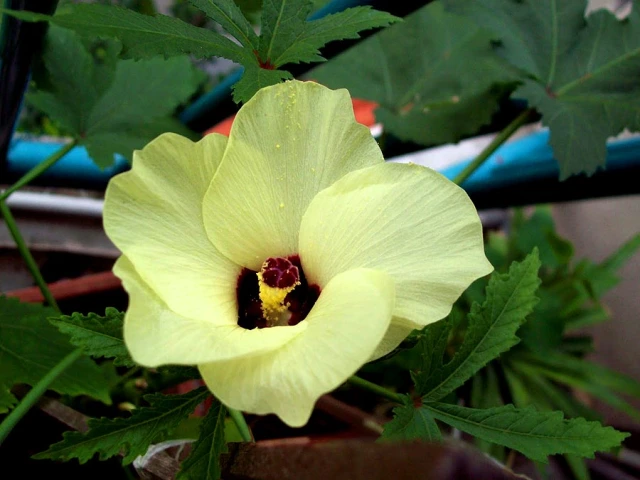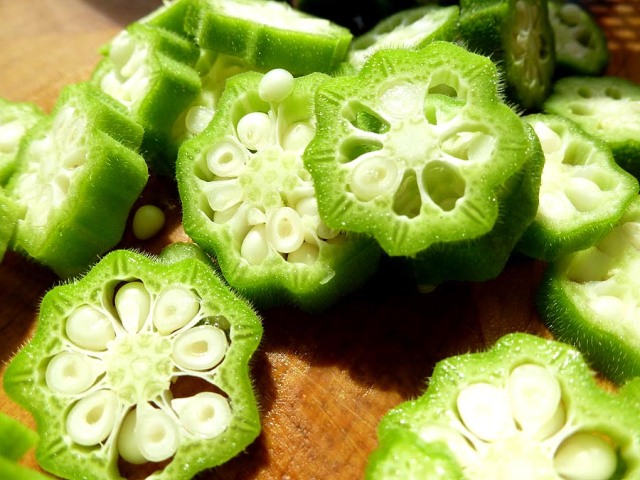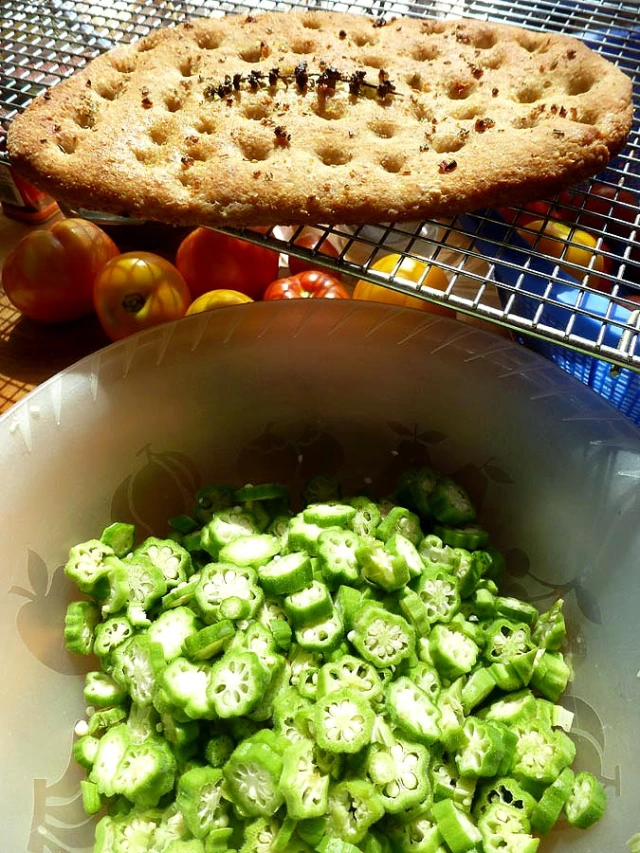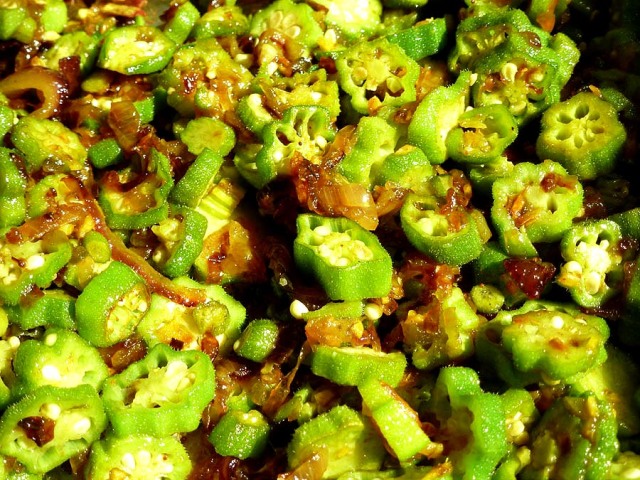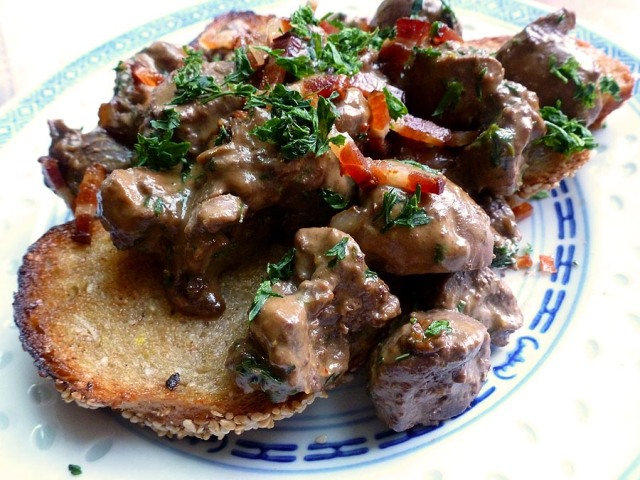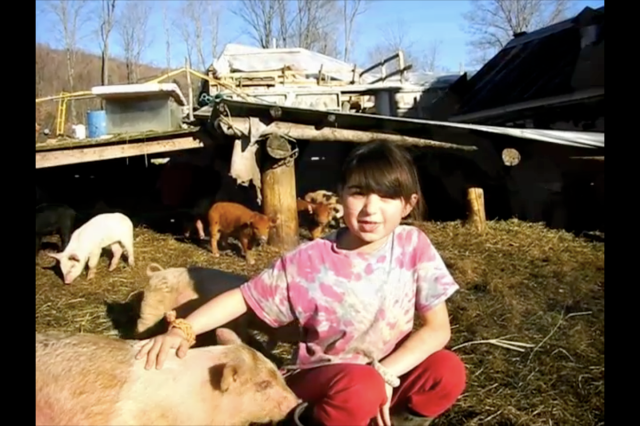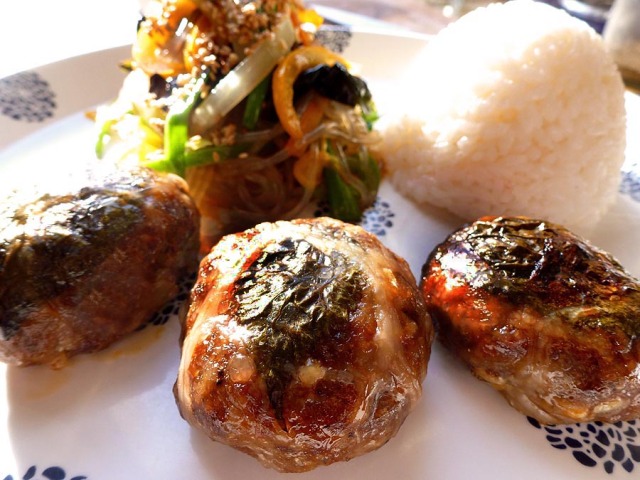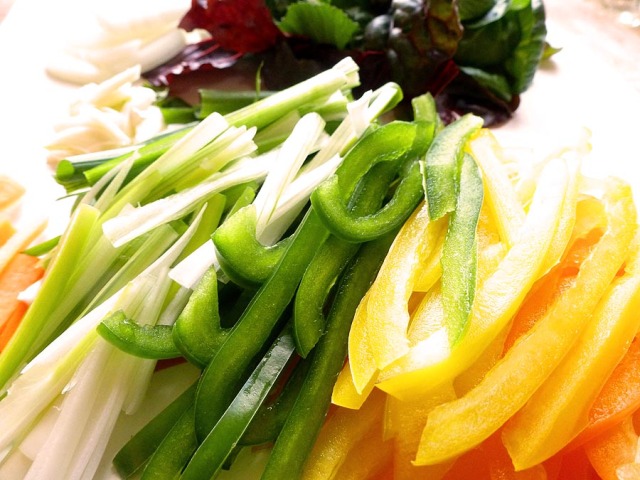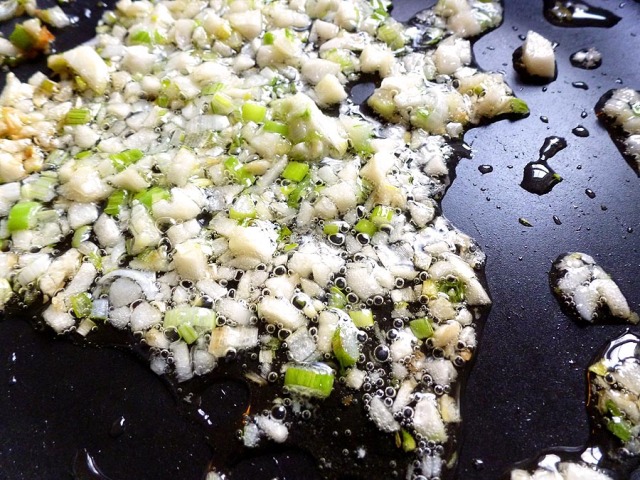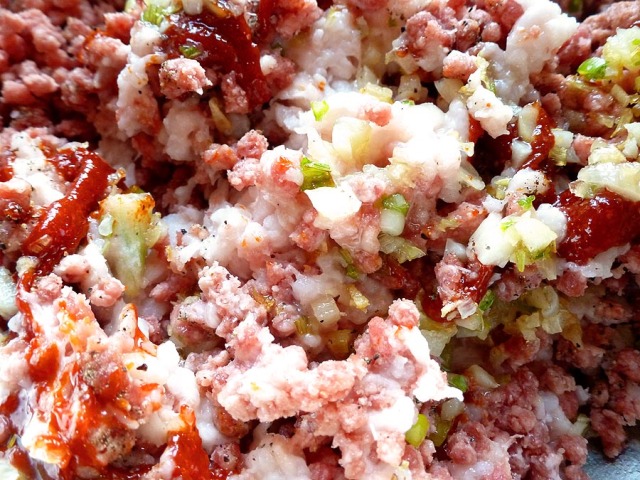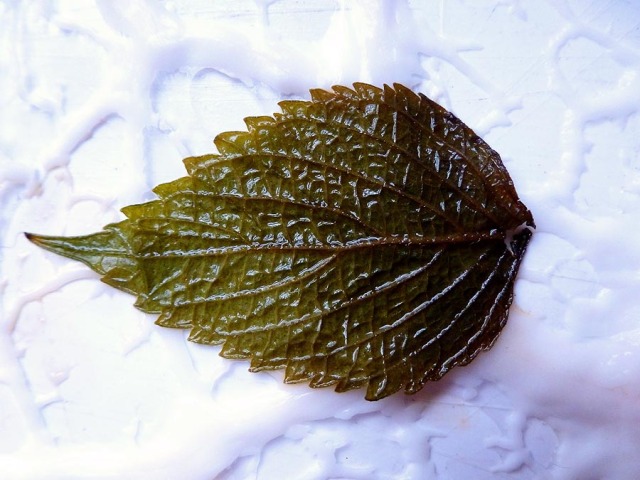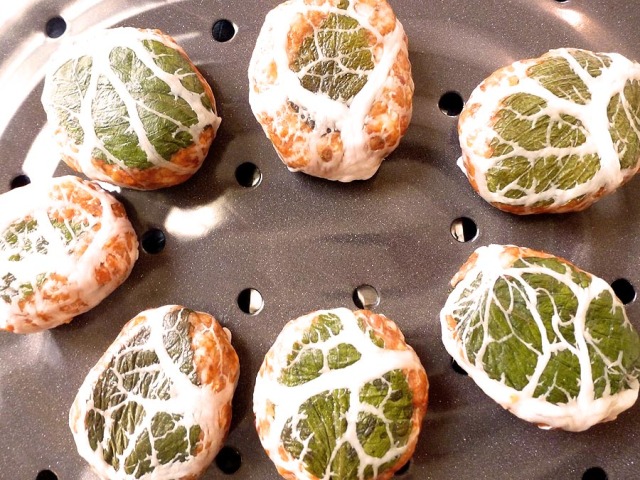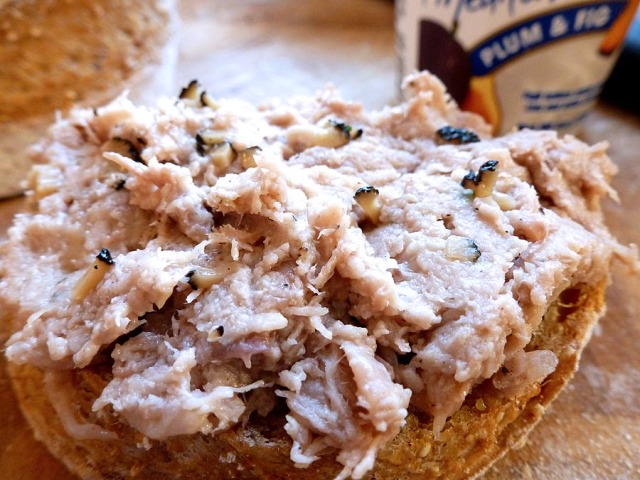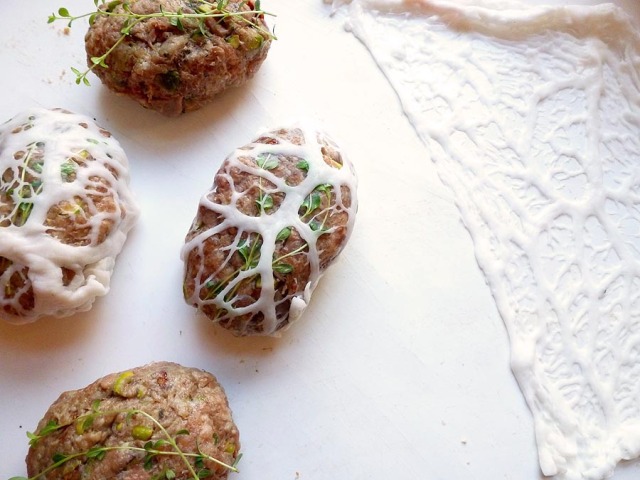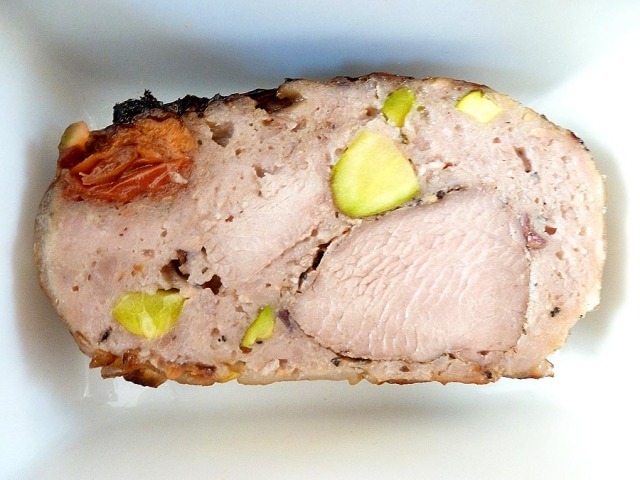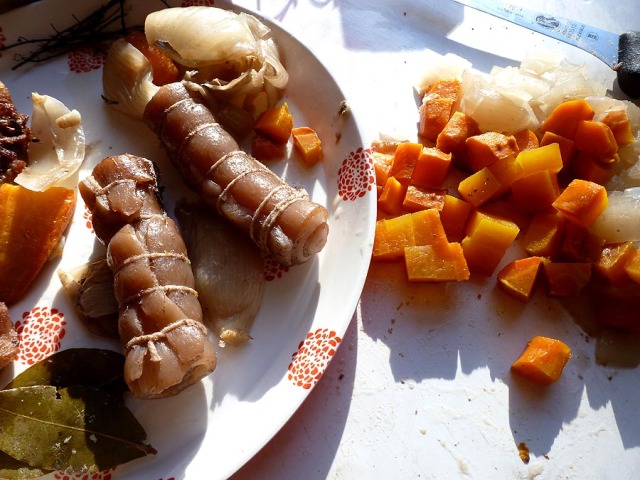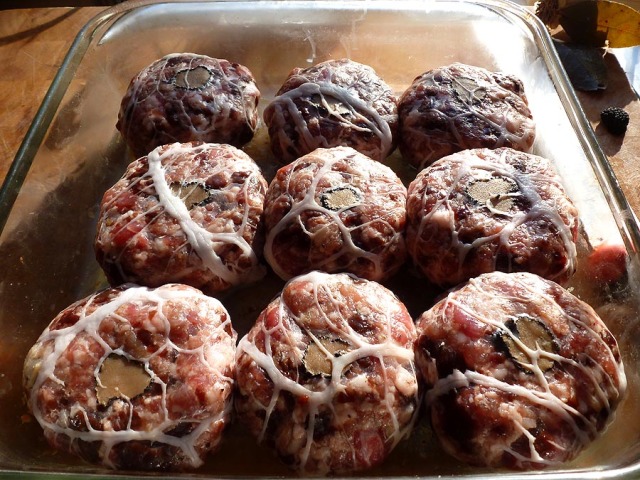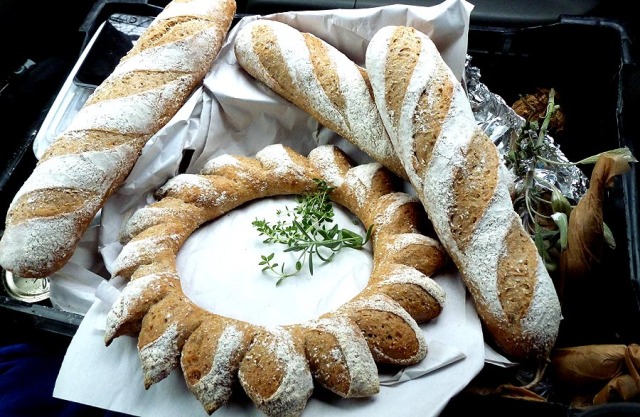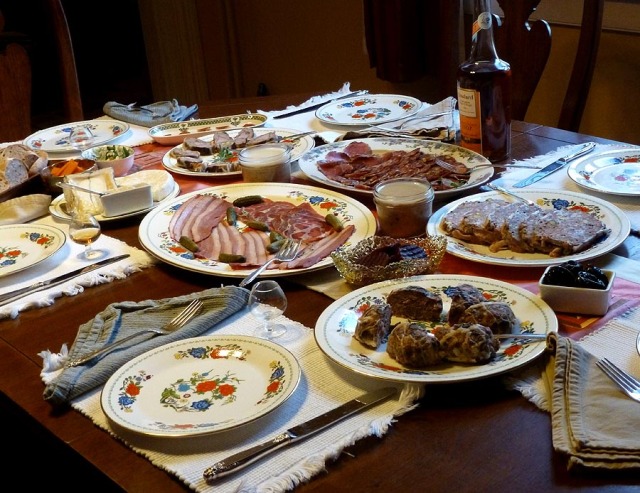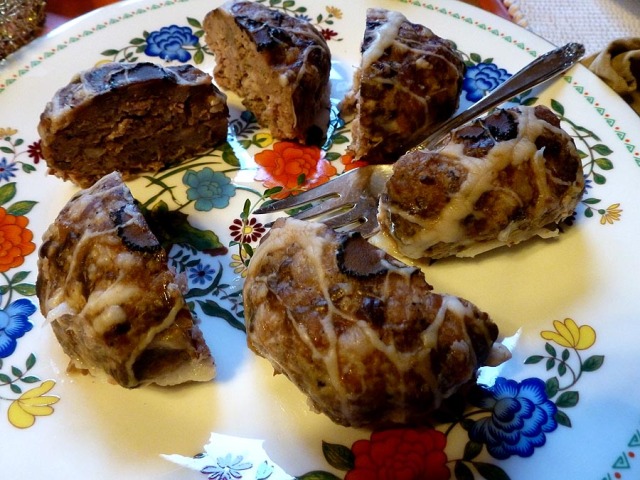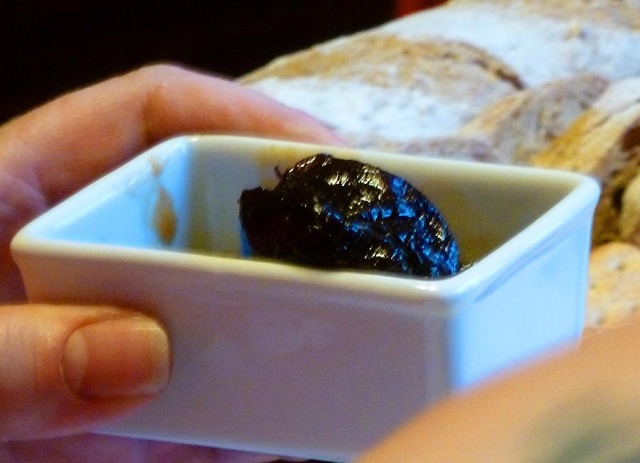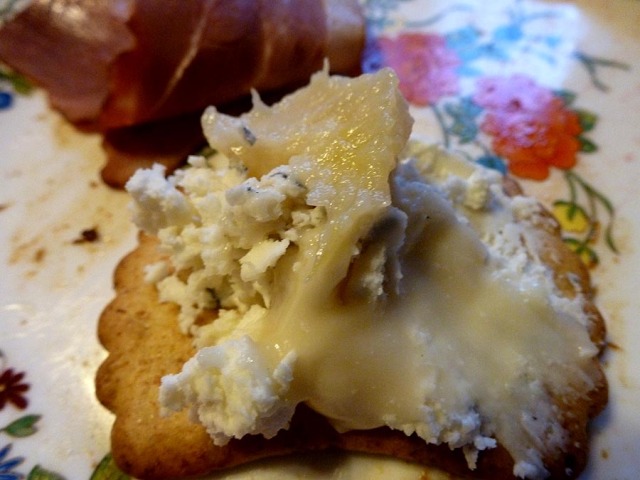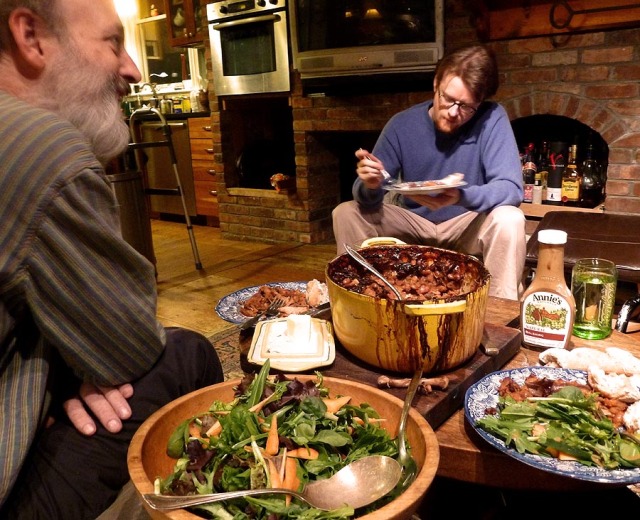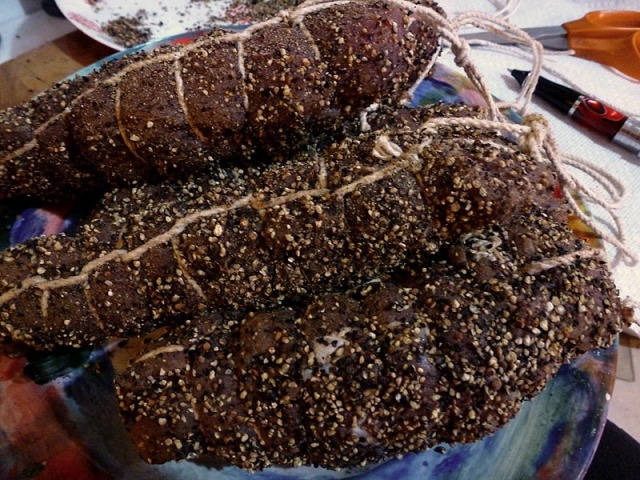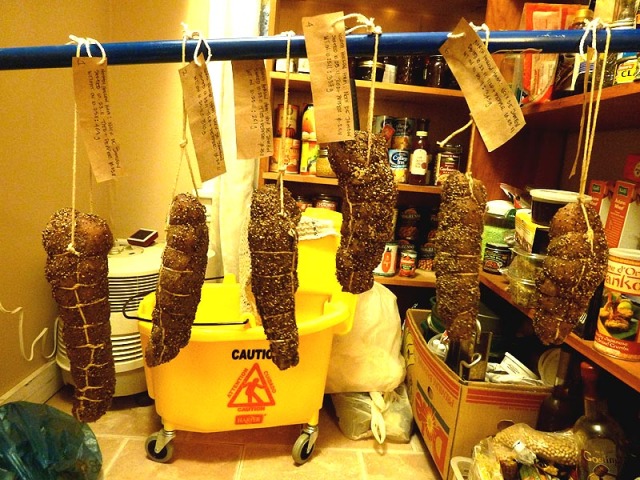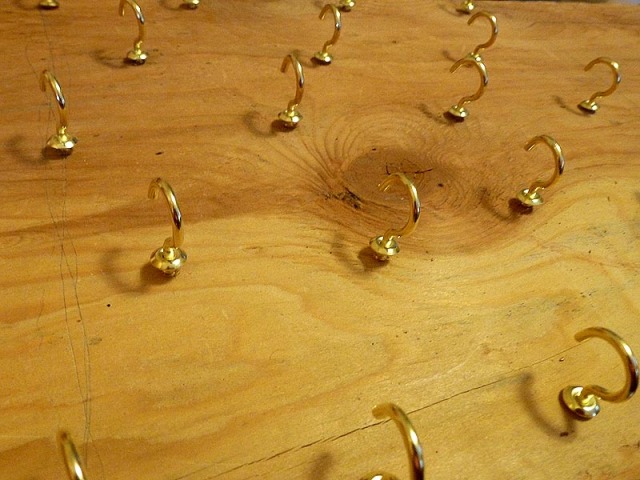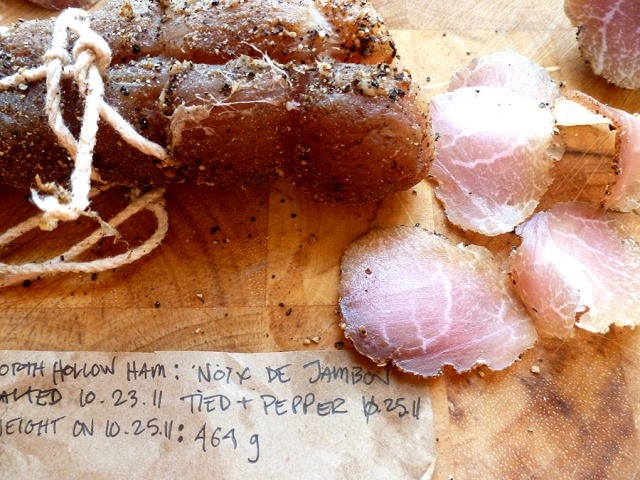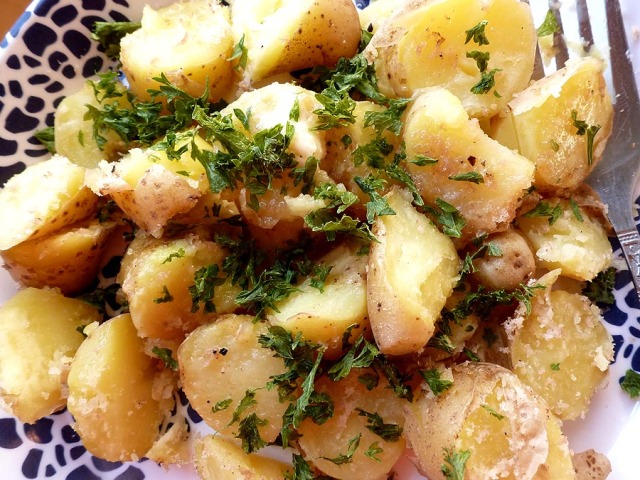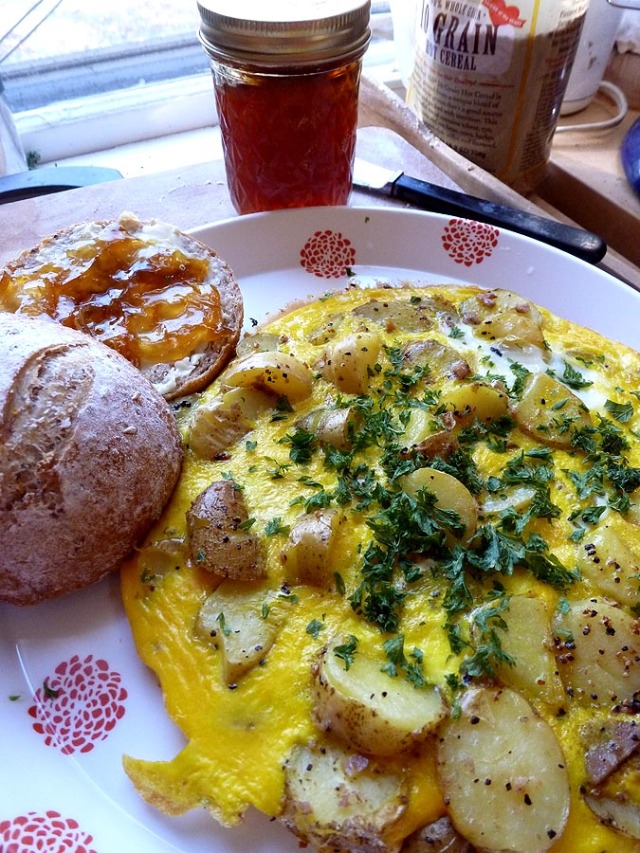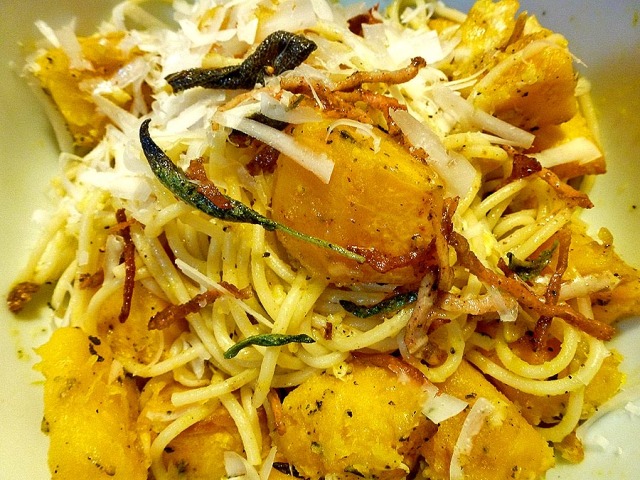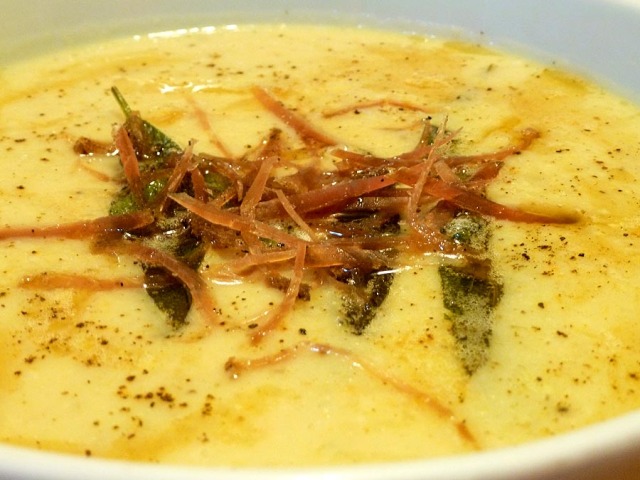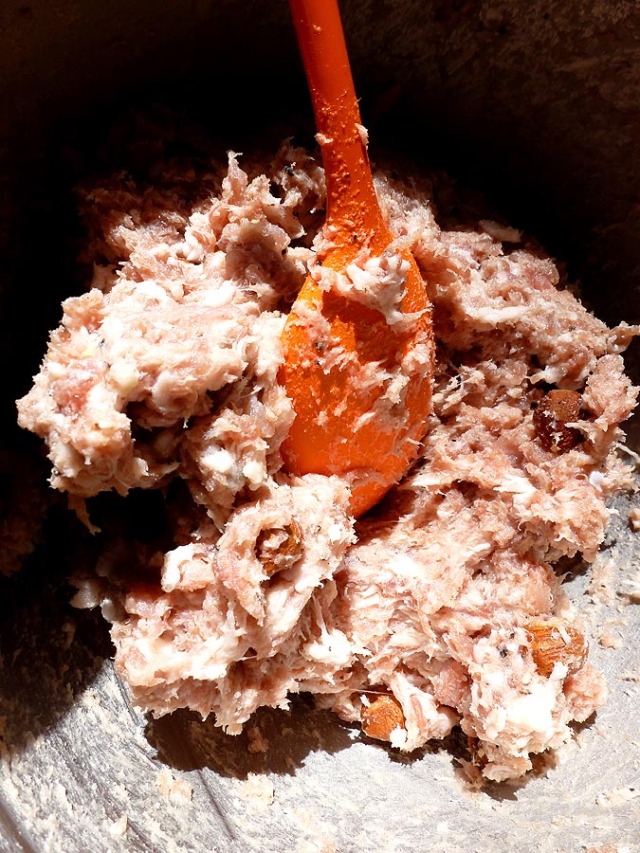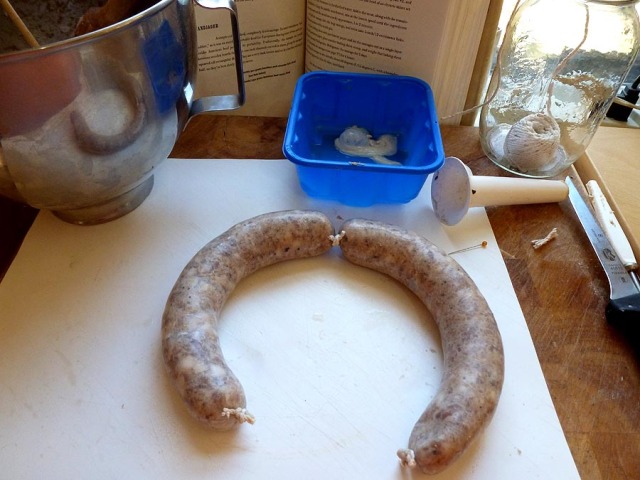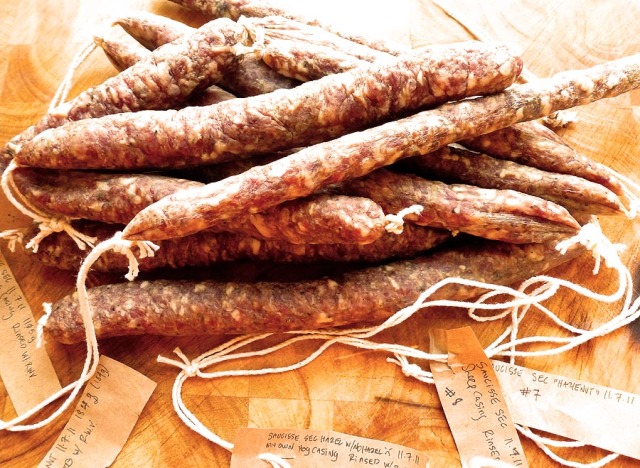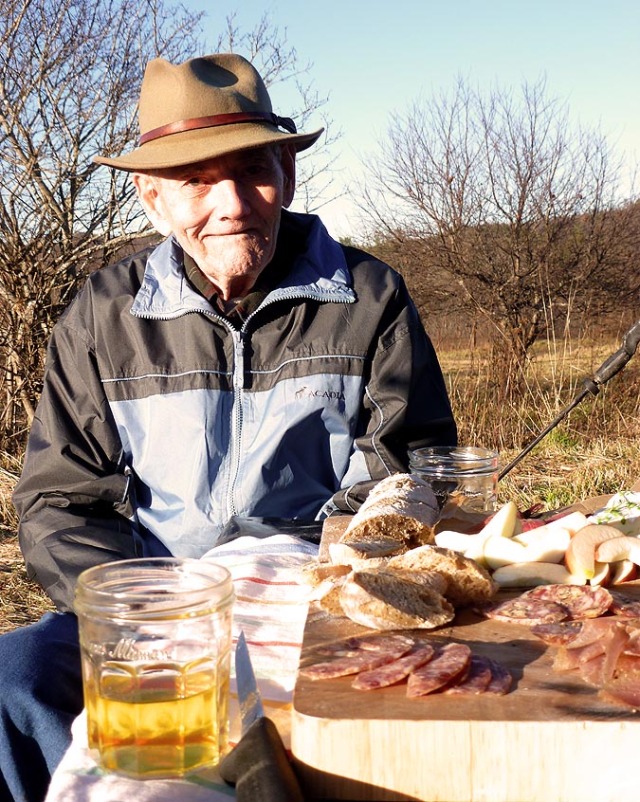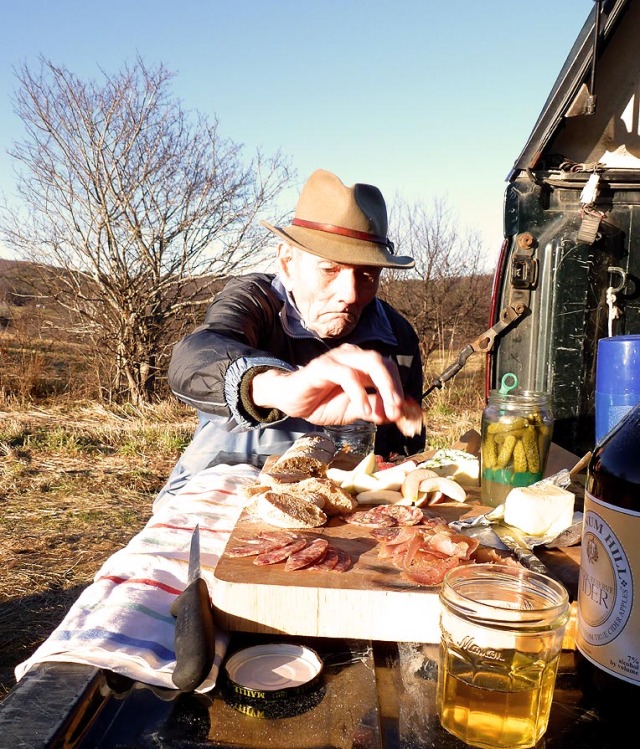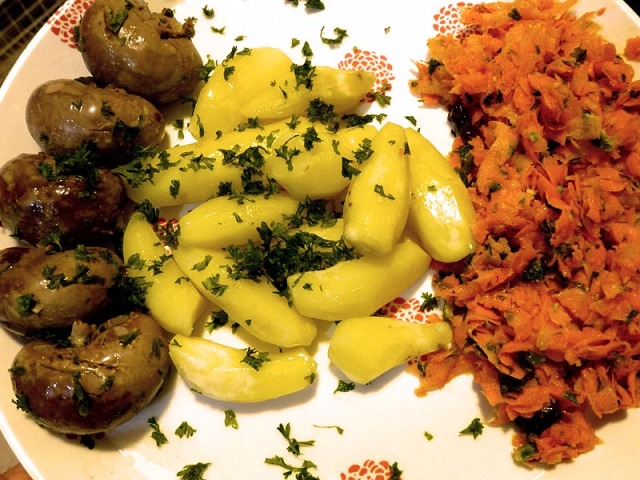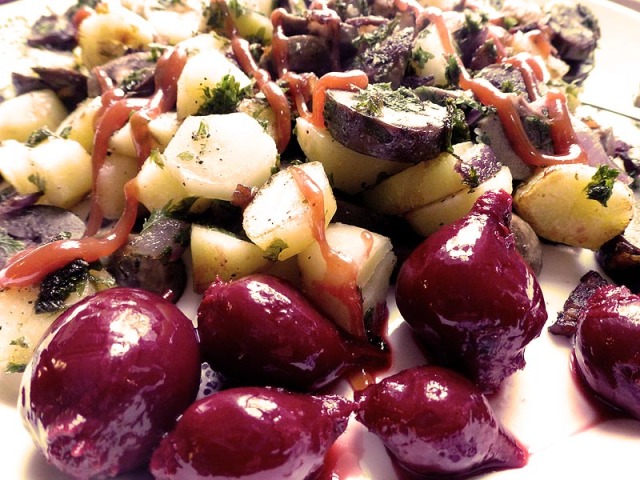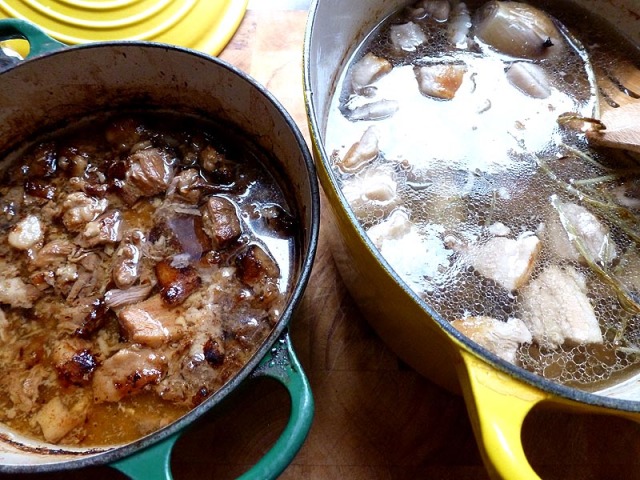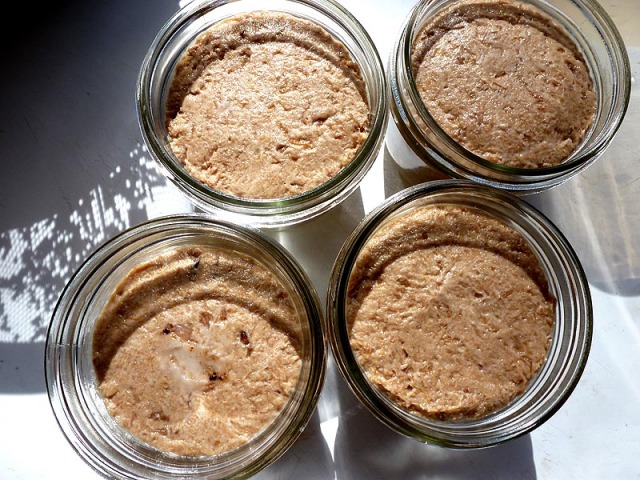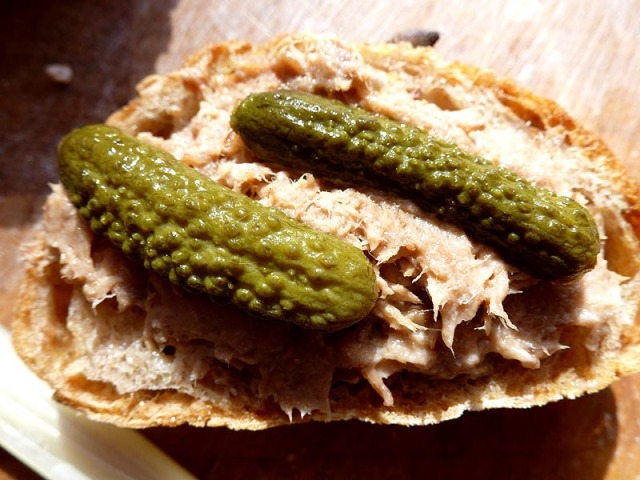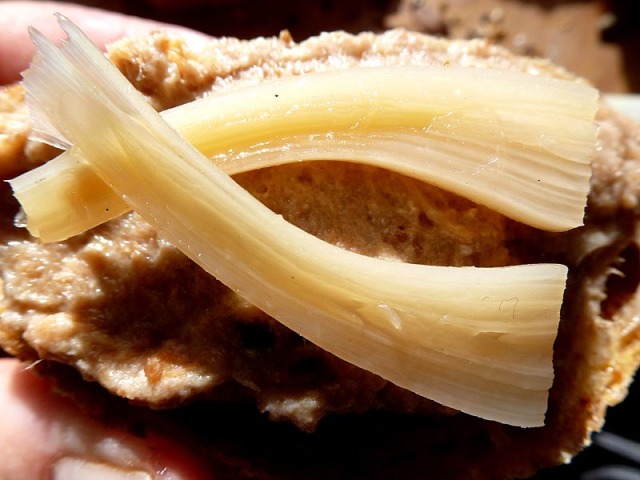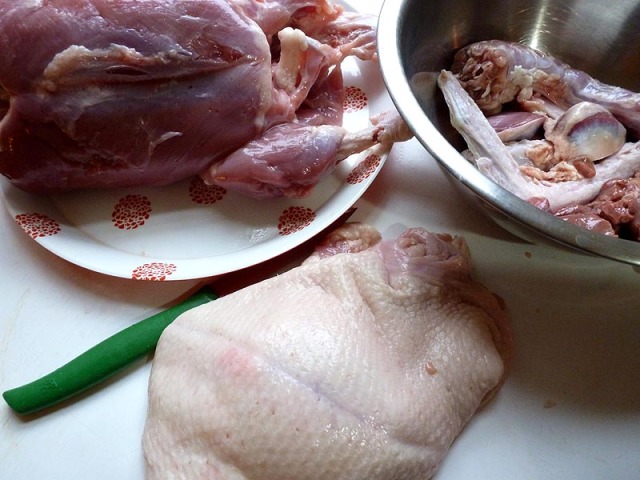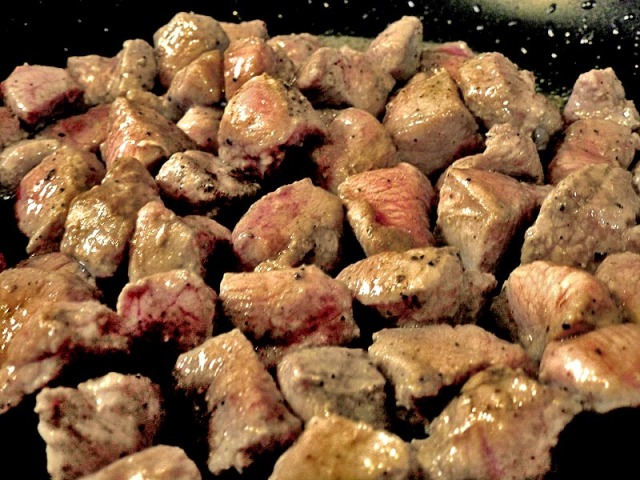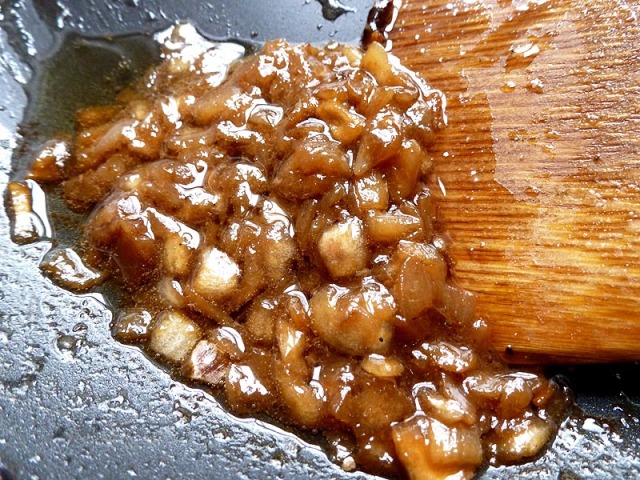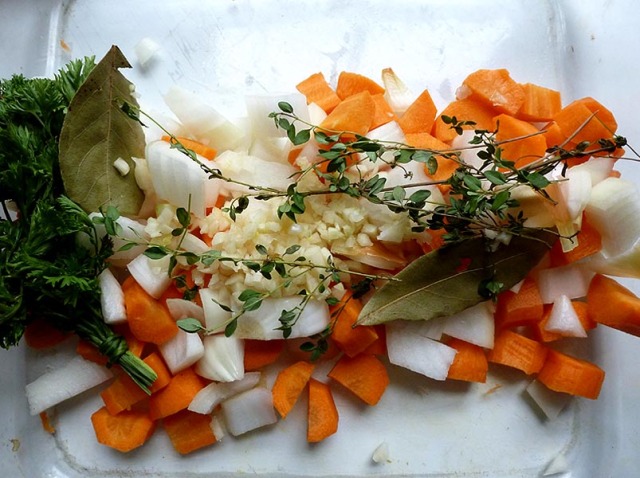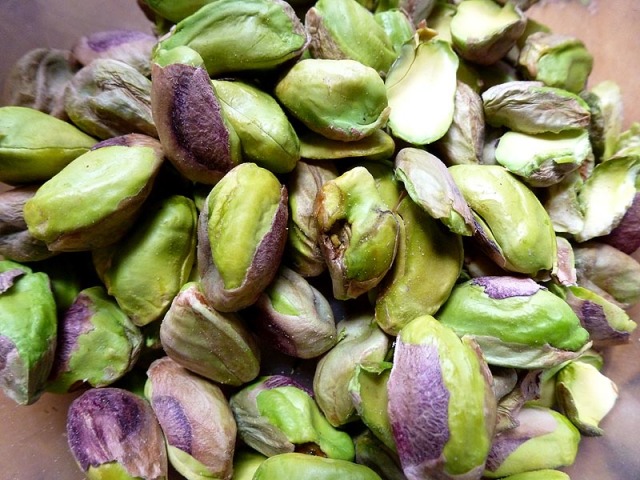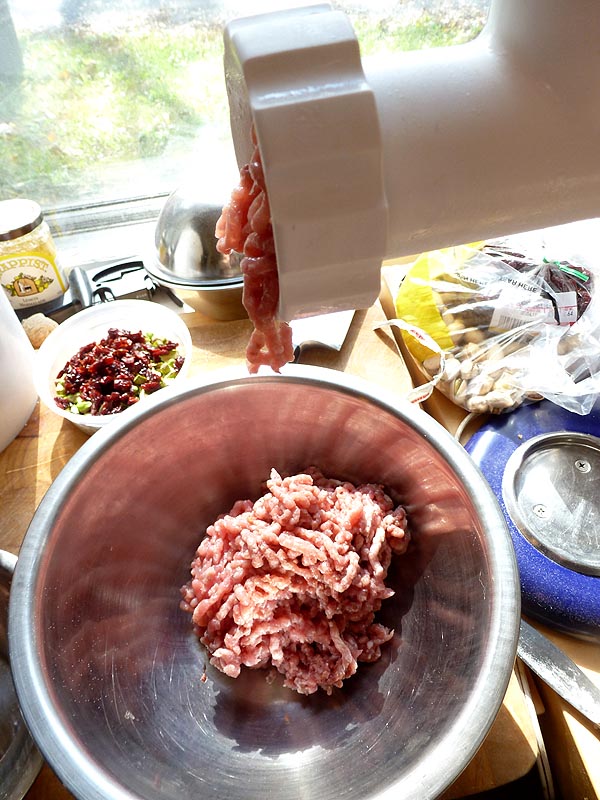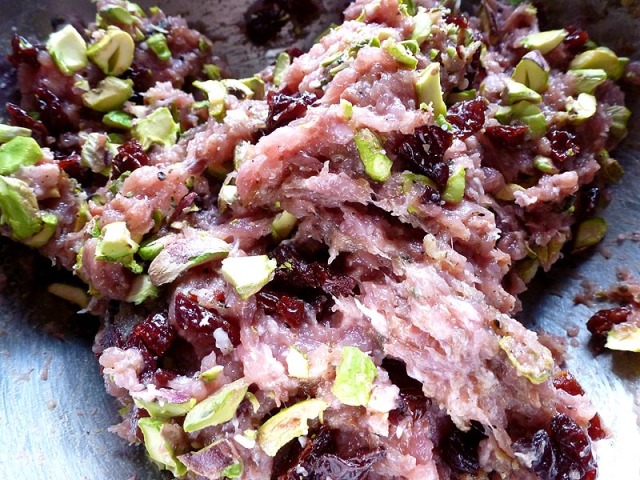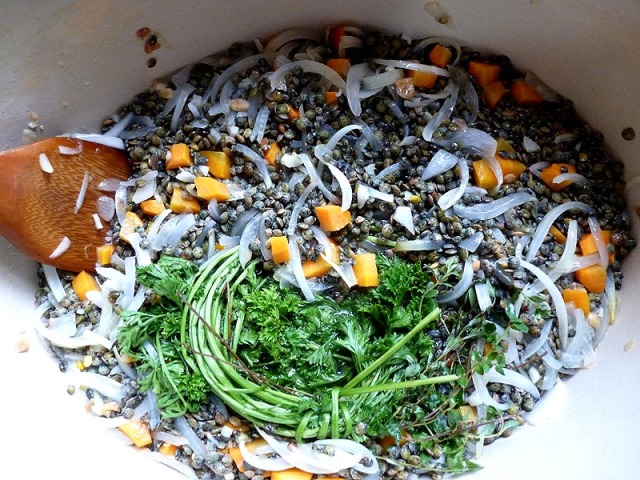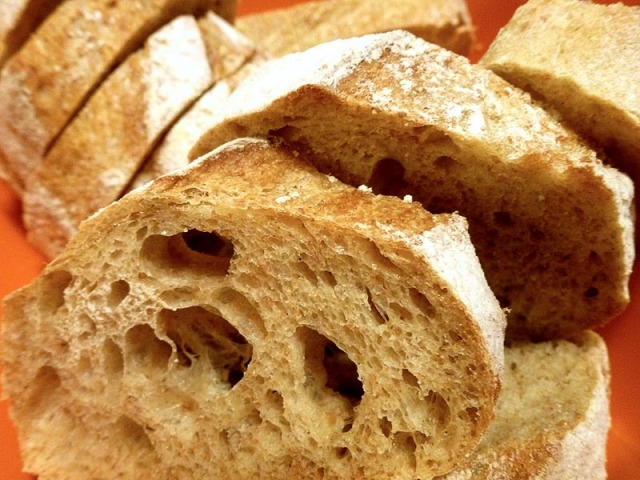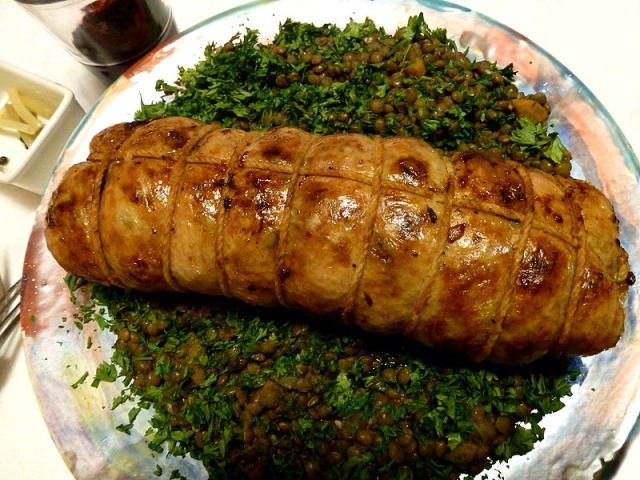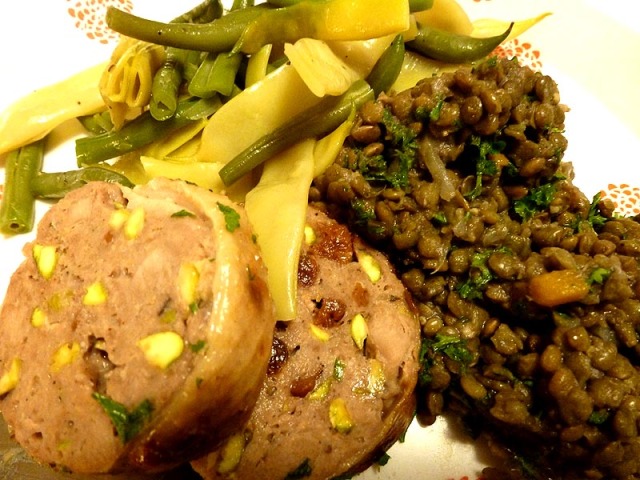From the Oxford English Dictionary:
† ˈpudding-time Obs.
The time when pudding or puddings are to be had; hence fig., a time when one is in luck; a favourable or useful time.
1667 Dryden & Dk. Newcastle Sir M. Mar-all iv, Here he comes in pudding-time to resolve the question.
I’d never come across this figure of speech until I decided to do a bit of research* in preparing to write this post, and technically this meaning is obsolete, but it delights me that despite not intending to keep prodding at the notion of grace, this expression pops up in my first project write-up of the new year with its connotations of auspiciousness, favor, and luck. So I’ve resolved that 2012, all twelve months of it, will be pudding-time.
I watched the first episode of How to Cook Like Heston last week, and was instantly taken with the idea of making my first beef and kidney pudding; I’d been wanting to attempt it for years, and Heston’s version with oxtail and kidney seemed a good combination of traditional provenance and saucy innovation. This dish involves suet pastry, new to me, about which I still have lots of questions (see end of post), and it was a steamed meat pudding as opposed to a baked meat pie, so the moving-picture aspect of Heston’s TV program boosted my pastry-steaming confidence; a thousand words, etc.
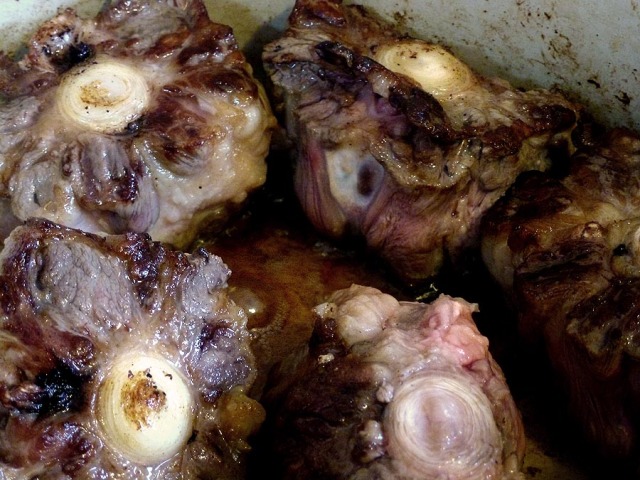
Oxtails undergoing the Maillard reaction, aka `browning,' vital to achieving maximum beefy deliciousness
First was sourcing the oxtail. My local supermarket didn’t have any, but I was informed that I could request a minimum order of thirty POUNDS at SIX DOLLARS PER POUND. Yes, I did get a bit shouty; thank goodness the butcher at my local supermarket, while not technically functioning as a butcher, is a good friend, and he agreed it was a ridiculous price and that I should look elsewhere.
I called a larger supermarket twenty minutes north of here and the meat man did have oxtail, and when I asked if he would sell me five pounds of it for $3.99 instead of their normal price of $4.99, the nice man agreed. Still, despite the prevailing description in almost every recipe and cookery book of oxtail as cheap, poor-man’s meat, frugal, etc., this meat is not cheap. Having completed this project, and knowing that I’ll have gotten three or four dinners for between two and three people out of this splurge soothes the sting a bit, but still.
So many cuts of meat which for years were described as cheap or frugal, a real boon to those of us who have little to spend, have now become popular, and have therefore shot up in price.

A pair of pretty oxtails
A case in point: a local progressive meat department has been sourcing locally, sustainably reared pigs, and then slaughtering the whole beasts themselves (what a concept!) and offering the pork for sale. I discovered that they were just throwing away the leaf lard –yes, I did nearly fall over sideways. Putting on my best nonchalant face, I asked if I might come and collect it once a week. Sure thing! said the nice butcher. The very next week I arrived at the meat counter and was told that the leaf lard had suddenly exploded into popularity and was now $5.00 per pound. Really? Hmph.
Back to the pudding.
I’ve not strictly adhered to the recipe, but followed rather the dictates of my larder as well as my dogged disinclination to leave the apartment while it’s so gray and cold outside. Also, I don’t have a pressure cooker or crock pot but was very happy with my big oval enameled cast-iron pot, which has a capacity of four liters, which was just enough.
First I gently cooked a mixture of sliced celery, carrots, and leeks in a bit of grapeseed oil, over medium-low heat, for ten to fifteen minutes. I didn’t have as much leek as was called for, so made up the difference with onion.
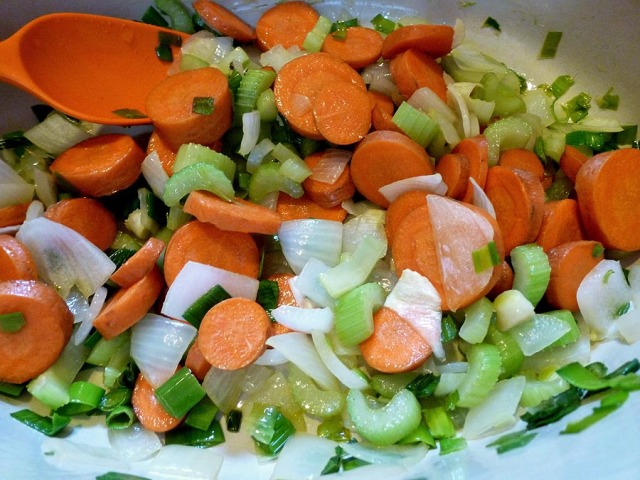
Sliced carrots, celery, leeks, and a bit of onion cooking over gentle heat
Removing the softened veggies to a bowl, I added a bit more oil, and sweated the onions and star anise for ten minutes until the onions were soft, at which point I added the first veggies back to the pot and stirred them over low heat for five or six minutes.
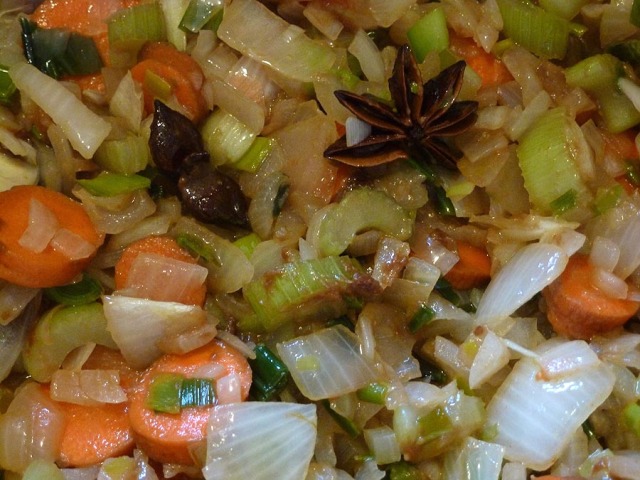
All the vegetables getting acquainted
Once the veggies were done, I used a silicone spatula to scrape every last morsel into a large bowl, and set it aside. There wasn’t any appreciable fond, er, sucs, which makes sense as I hadn’t meant to color the veggies up much, so I didn’t deglaze the pot as was recommended at this point. [Update: next time I’ll aim for a bit more browning.]
Back on the heat, I added a bit more oil, turned the heat up to medium-high, and once the oil was good and hot, browned my nine fat oxtails in two batches, a picture of which is at the top of the page.
While the oxtails sizzled, I added a few bits and bobs to the bowl of cooked veggies: a bay leaf, some summer savory instead of the thyme called for, a teaspoon or so of crushed black pepper, and a quarter cup of my own extremely concentrated roast-tomato sauce/paste (instead of tasteless winter store-bought tomatoes), and one substitution that really pleased me..
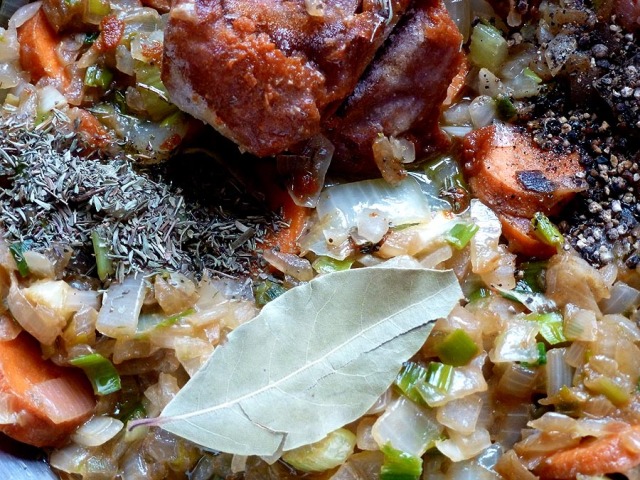
Veggies, spices, roasted tomato paste awaiting their all-day play-date with the oxtails
The recipe calls for mushrooms to be cooked and added to the rest of the veggies and aromats, but I had no mushrooms. No fresh mushrooms, and my vast store of dried ones were packed into boxes just last week for the upcoming move. I really did not want to go out, so I thought about what the mushrooms would add, which in my experience is a rich umami depth of flavor, a sort of round, low, lyric baritone savoriness. I thought: why not a big heaping spoonful of hatcho miso? It seemed right to me.
By now the oxtails were all nicely browned; I piled them carefully atop the bowl of veggies and paid 100 percent attention as I poured all the oil out of the pot (an old tin can comes in handy for this operation), careful not to discard any of the lovely browned bits which weren’t stuck to the pot bottom. Wiped a drip of fat off the outside of the pot, and back onto the heat.
In went a combination of red wine and brandy, which I got to ignite! With a wooden match! Look, mine is for the most part a quiet existence, and this is the sort of acrobatic cooking hijinx that I live for. It really was quite dramatic; you have to picture me standing on one leg, hip pressed against the oven, lighter in one hand, old ratty match in the other, set the match ablaze with the lighter, quickly pick up my camera, bring the match toward the pot and WHOOF! A big lovely blaze of alcoholic fumes, my camera is entirely undamaged, and I still have all the hairs I started out with. Finally I plonk back down into my chair and just enjoy the fire, old pyro that I am.
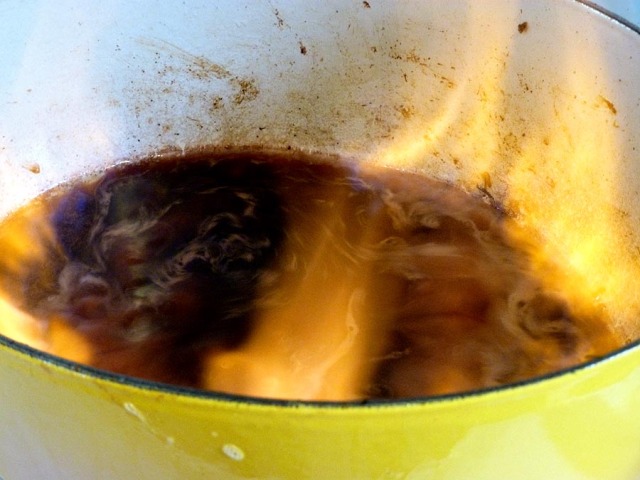
The inebriating fumes all cheerily ablaze
Once the flames had died down, I stirred and scraped the bottom of the pot to loosen all the delicious bits of suc to create a fond, and then added back into the pot everything from the veggie bowl except for the oxtails themselves, which I held back momentarily.
Heston’s recipe calls for 750 grams each of beef and chicken stock or a total of a liter and a half of liquid. Because of moving-related upheaval and my denuded larder, I didn’t even have any tinned stock, much less good home-made stuff in the freezer, so I added just over a liter of water, and a large spoonful of good beef boullion. I didn’t use the entire 1500 grams of liquid because I guessed, rightly it turns out, that the pot would overflow if I used the full complement of liquid in addition to the vegetables and oxtails. The purpose of the liquid is to thoroughly cover the solid bits, so that as much flavor as possible leaches into the suspension, and once the braising is finished and the solids strained out, the liquid will be reduced by a third or half, so the slightly diminished quotient of liquid was hunky dory.
I warmed and stirred the veggies and spices, water, wine, brandy, and boullion, and tasted a spoonful of the liquor. Once warm, even at this early stage, it was evident that with all the good ingredients, as well as the lip-smackingly savory oxtails with all their meat, collagen, and bones, that this broth was going to turn out well, but it was still missing some of those deeper notes mentioned above. Now is when I took a large mounded dessert-spoonful of hatcho miso and dissolved it in a measuring cup with some of the warm broth, and then added it back into the pot. The improved depth and roundness of flavor was immediately apparent when I took a second taste. Excellent.
I carefully tipped the oxtails into the pot, making sure that they were fully submerged, put the lid on, and placed the whole (heavy) thing into a 250°F/130°C oven and let it cook for six hours or so, checking every now and again to make sure it stayed at a low simmer. As the afternoon passed, my apartment smelled more and more of meaty, juicy promise.
Once the oxtail was well and truly falling off the bone, I turned off the oven, set the covered pot on the counter, and went to bed.
***
Next morning I got a long-fermented lump of dough rising and the oven preheating for the daily bread, and proceeded to pick all the meat off the oxtail bones, scraping to get every last bit of collagen off the ends. That stuff is gold. What I couldn’t scrape off into my bowl of meat I gnawed off with my teeth; cook’s treat.
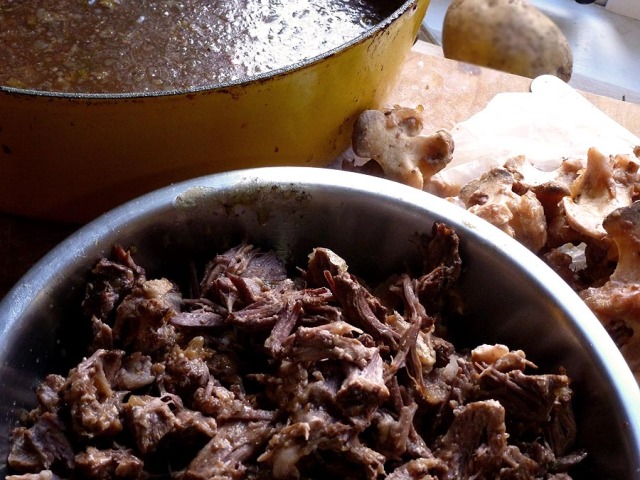
Picking the now-tender bits of meat off the bones
Once the meat was all picked over, I heated up the cool and thus jiggly broth until it was fully liquid again and then poured it through a sieve; I wasn’t looking for a perfectly clear sauce, so I scraped and turned the veggies around in the sieve fairly vigorously. The broth went back into the pot and reduced via a brisk simmer over medium heat by about a third. I ate the well-braised veggie leftovers with some crusty bread & butter; delicious.
Heston used veal kidney; I used pork kidney, and I used a bit more than his recipe calls for, as I relish kidney most of all offal. I trimmed it, chopped it into half-inch chunks, and added it to the bowl of oxtail meat. Then the reduced and almost-cooled gravy was added to the meaty mix, all glossy and delicious. I did not keep aside a portion of the sauce to later be injected into the finished pudding. I like the idea, I really do, but the middle of the day was about to turn pear-shaped, and besides, I couldn’t find my syringes. Next time.
At this point my carefully planned-out cooking & baking timeline imploded as a fire developed inside my oven. Apparently some fatty broth had sneakily drizzled its way to the floor of the oven during yesterday’s oxtail braise-a-thon, hidden from sight by my baking stone. First there were clouds of nasty white smoke collecting under the ceiling, headache-inducing alarms for 4o minutes or so, a freezing apartment due to having doors open at both ends –yep, like that.
I had hoped that the “bit of fat” might just burn off, but I was wrong, and soon a little fire started inside the oven. At this point I called the local firemen and got dressed. By the time the three exceedingly handsome firemen in all their sexy fireman gear showed up, the fire had gone out. Not my finest moment, but almost worth it. I really like firemen.

Parisian firemen wear black uniforms, trimmed with reflective yellow and silver, with shiny silver hats. A group of these Parisian firemen, real working firemen, also have a gymnastic circus act.
My plan was to bring enough of the meat mixture, along with enough ground suet to make the pastry up to my mother’s house, assemble and cook everything there, so I packed it all into a box and headed north.
***
The pastry called for self-rising flour, which I never buy. When I do need it, I make up my own from all-purpose flour, baking powder, and salt. The ratio I learned is a quarter teaspoon of salt and one and a half teaspoons of baking powder for each cup of flour.
The pastry recipe calls for five hundred grams of flour, which is approximately four cups. Six teaspoons of baking powder seemed a lot, though the one and a half teaspoons of salt seemed about right. That was the self-rising flour sorted.
Fifteen additional grams of baking powder, approximately three teaspoons, and one more teaspoon of salt. I added two teaspoons rather than three of the baking powder. Nine teaspoons in total just seemed a huge quantity. I blitzed this all in mom’s food processor, and then added the two hundred and fifty grams of ground suet. Suet is a crumbly, dry fat, and I had read that a suet-based pastry can take (in fact, needs) more water than a butter or lard-based pastry. This recipe called for three hundred milliliters of cold water, which I measured; it looked to be around a generous cup or so. I added that to food processor as I pulsed, and I pulsed until the pastry just came together, at which point I removed it from the processor bowl and kneaded it briefly on a lightly floured board. Once it was just together, I formed it into a fat sausage and wrapped it in cling film, and then into the ‘fridge.
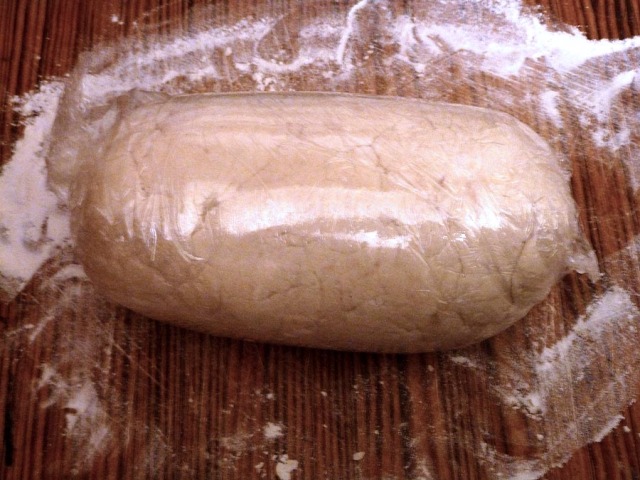
A fat sausage of suet pastry wrapped in cling film
Forty-five minutes or so before dinner-time, I took the pastry out of the ‘fridge; I cut three small chunks of approximately one hundred grams, and three more closer to eighty grams. I rolled each of the hundred gram pieces to about three millimeters thickness, and lined the three miniature pudding basins with the pastry, before filling them with the oxtail and kidney mixture. The basins were not any sort of special British pudding basins; just plain ten-ounce glazed stoneware with what seemed like the right shape. I think a proper one would have some sort of lip so that string or a rubber band could more easily be used to secure any parchment or paper covering.

Three make-do pudding basins lined with suet pastry and filled with the oxtail & kidney mixture
I rolled out the three smaller chunks of pastry into 6 mm-thick lids, beat a small egg and used it to brush the edges of the pastry lids, pressed them onto the edges of the pastry lined basin, and crimped them together as best I could.
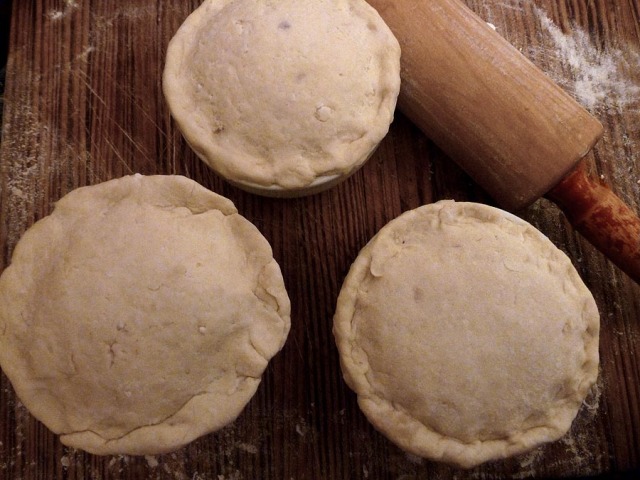
The puddings with their lids on, nearly ready to steam
I cut out pieces of parchment paper of a suitable size, and did a slightly sloppy job of attaching them over the top of each basin with a rubber band, then lowered them carefully into a pot with several cups of simmering water. It seems to be ideal if the water reaches halfway up the outside of each basin.
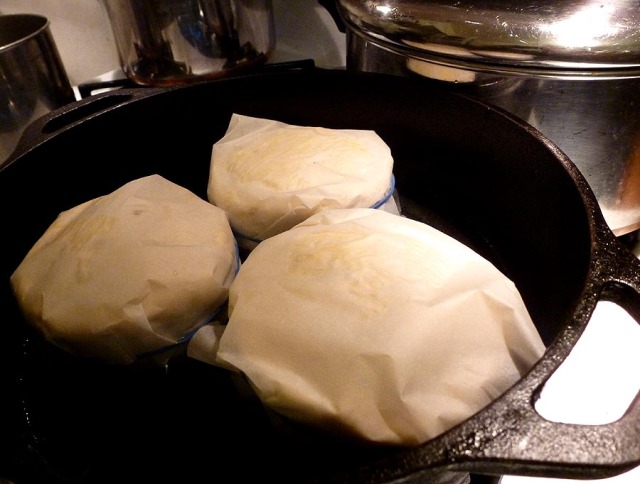
Steaming the oxtail and kidney puddings
On with the tight-fitting lid, and the puddings steamed quietly away while mom finished up the mashed potatoes and I finished cooking the buttered peas.
At last it was dinner-time, and time to unmold our puddings..
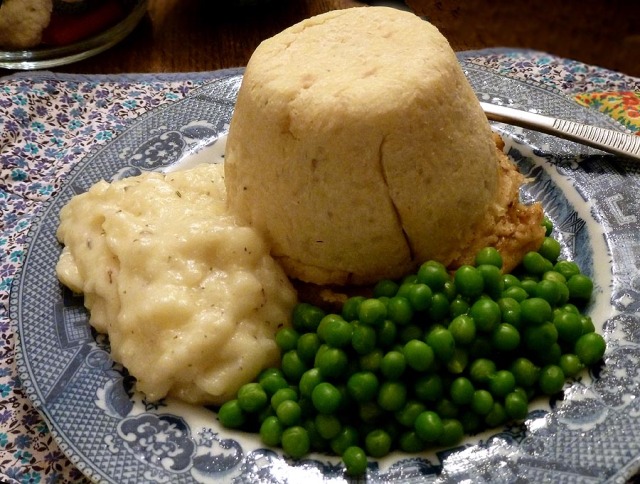
The puddings are perfect!
They were perfectly delicious, and dinner as a whole was the very definition of comfort. Even though I didn’t manage to inject them with extra sauce, they were laden with gravy, hearty, and warming, and the buttered peas and mash were just the right supporting cast. I was particularly pleased with the pillowy, almost dumpling-like softness of the steamed pastry.
The next morning, back home. Leftover pastry & filling are in the ‘fridge, wooing me, so I invited my friend Jenn to come for dinner. She brought excellent cider, catnip for Mouse, and we had a perfect winter dinner of parsnip & potato mash, peas, and two more perfect oxtail and kidney puddings. Curled up on the sofa, watching Fanny Hill, sipping cider and occasionally nodding off. Bliss.
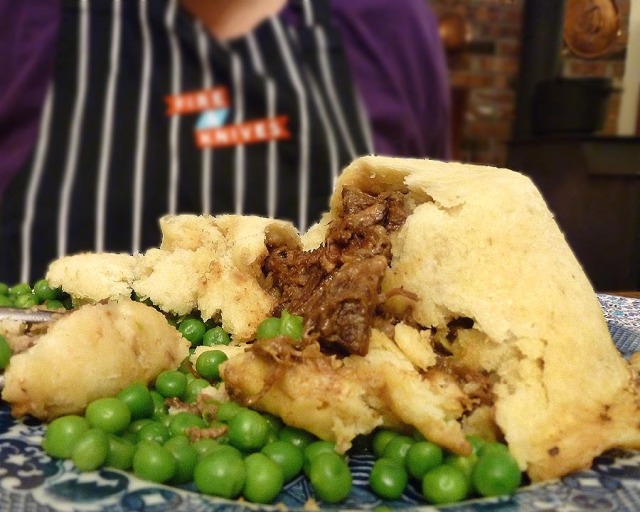
Savory oxtail & kidney pudding contained in the tender steamed pastry
If you’ve read this far, and you happen to be a suet pastry expert, I have some questions.
- Why does suet pastry have so much leavening, taking into account the baking powder built into the self-rising flour in addition to the added baking powder? Is this common, or is this a more experimental Heston-esque version?
- Can this type of suet pastry be used for a baked pie as well as a steamed one, or would another type of pastry be more appropriate?
- I know that I can keep savory shortcrust pastry in my freezer, well-wrapped, ready to use when I need it. How does suet pastry do with freezing?

